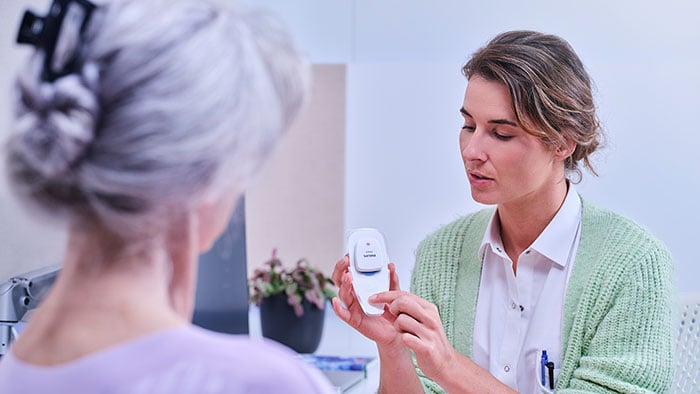2024 Future Health Index insights reveal how cardiology leaders are tackling the rising tide of chronic heart disease
Virtual care, automation, and AI are critical to help meet growing demand for acute cardiac care and chronic heart disease management
Aug 29, 2024 | 3 minute read
Global increases in lifestyle and age-related diseases, such as type 2 diabetes, cardiovascular disease, stroke, and dementia, continue to put an unsustainable burden on healthcare systems and societies worldwide. Cardiology leaders are highly aware of the situation. In 2020, an estimated 523 million people had some form of cardiovascular disease (CVD), and approximately 19 million deaths were attributable to CVD; this represents approximately 32% of all global deaths, an increase of 18.7% from 2010 (1,2).

Burn-out rates among healthcare professionals, including cardiologists, are already high. In order to relieve the administrative burden and cost-of-care while still ensuring patient deteriorations are detected and treated before re-hospitalization is required, cardiology leaders are increasingly looking to remote patient monitoring, virtual care, AI and automation as solutions.
Confidence in virtual care to ease staff shortages
In the Philips Future Health Index (FHI) 2024 Global Report – the largest independent survey of its kind featuring insights from nearly 3000 healthcare leaders from 14 different countries – 75% of cardiology leaders surveyed say staff shortages are impacting patient care at their organizations. Results show more than half (58%) of cardiology leaders indicate virtual care helps ease pressure by enhancing the capacity to serve patients and reducing clinical response times.
“The FHI 2024 findings indicate that staff shortages are not only delaying patient care, but cardiology leaders are also concerned over how these issues may result in staff leaving, resulting in even more resource constraints,” said Dr. Atul Gupta, Chief Medical Officer of Diagnosis and Treatment at Philips. “The good news is nearly all healthcare leaders surveyed in the 2024 Future Health Index (92%) believe that automation of repetitive tasks and processes is critical for addressing staff shortages, and an equal percentage think it will save healthcare professionals time by reducing administrative work – allowing them to spend more time with patients.”
Cardiology leaders turning to AI
Having the right tools to analyze the vast amount of monitoring data generated will be key to personalizing cardiovascular care so patients can be empowered to take advantage of tailored treatments to help improve outcomes and reduce risk. More than 80% of those surveyed say their healthcare organization was either already using AI for clinical decision support or planning to use it in the next three years in the area of remote patient monitoring. Doing so has the potential to redefine the standard of care, ensuring the right treatment is provided to the right patient at the right time.
“Cardiology leaders are also quickly realizing the potential of AI, with 40% saying their organization plans to invest in generative AI in the next 12 months. The figures would suggest that healthcare organizations’ initial investment in generative AI has been in non-clinical informatics applications, which tend to be lower risk. Having seen what generative AI can do, cardiology leaders now seem to be more receptive to its use in clinical settings,” Dr. Gupta added.
Data integration challenges lead to unnecessary and repeat testing for patients
Reflecting the scale of the challenges they currently face, nearly all cardiology leaders surveyed (93%) said their organization currently experiences data integration challenges that impact their ability to provide timely, high-quality care, with unnecessary repeat tests/scans due to data inefficiencies cited as the top reason (46%).
On the administrative front, 90% of cardiology leaders agreed that automation will allow healthcare professionals to perform at their highest skill level, save time by reducing day-to-day admin tasks (91%), and mitigate staff shortages (93%).
Cardiology leaders looking to new business models to help contain costs
The FHI 2024 survey also revealed that cardiology leaders appear to be abandoning conventional fixed-cost technology buying options, especially in the longer term, with more than seven in ten currently using or considering using value-based models over the next three years. Finally, while cardiology leaders are aware of the need to minimize the environmental footprint of healthcare, with 92% and 86% agreeing that reducing CO2 emissions and the environmental impact of healthcare should be a top priority for governments and healthcare organizations respectively, they share the concerns of healthcare leaders in general that achieving environmental sustainability can be challenging in the face of current financial pressures.
About the 2024 Future Health Index
The largest global survey of its kind, the Philips Future Health Index 2024 is based on proprietary research conducted among nearly 3,000 healthcare leaders in 14 countries. Now in its ninth year, this year’s report explores how healthcare leaders view their organization’s ability to deliver timely, high-quality care to everyone. The report focuses on the gaps that stand in the way, as well as examining ways of overcoming them. The full report can be downloaded here.
Sources [1] Roth GA, Mensah GA, Johnson CO, Addolorato G, Ammirati E, Baddour LM, et al. ; Global Burden of Cardiovascular Diseases Writing Group. Global burden of cardiovascular diseases and risk factors, 1990–2019: update from the GBD 2019 study. J Am Coll Cardiol 2020;76(25):2982–3021. CrossRef PubMed
[2] Tsao CW, Aday AW, Almarzooq ZI, Alonso A, Beaton AZ, Bittencourt MS, et al. Heart disease and stroke statistics — 2022 update: a report from the American Heart Association. Circulation 2022;145(8):e153–639. CrossRef PubMed








